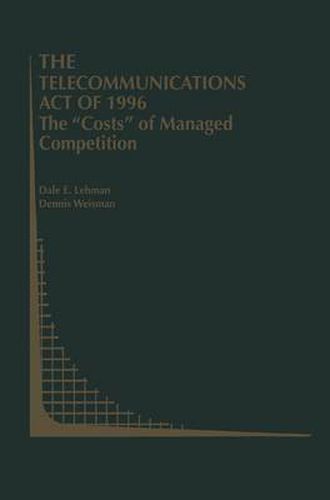Readings Newsletter
Become a Readings Member to make your shopping experience even easier.
Sign in or sign up for free!
You’re not far away from qualifying for FREE standard shipping within Australia
You’ve qualified for FREE standard shipping within Australia
The cart is loading…






This title is printed to order. This book may have been self-published. If so, we cannot guarantee the quality of the content. In the main most books will have gone through the editing process however some may not. We therefore suggest that you be aware of this before ordering this book. If in doubt check either the author or publisher’s details as we are unable to accept any returns unless they are faulty. Please contact us if you have any questions.
The Telecommunications Act of 1996 envisioned a competitive free-for-all in the U.S. telecommunications industry with removal of barriers to entry in local telecommunications markets and the lifting of the artificial restrictions that kept the Regional Bell Operating Companies (RBOCs) out of the interLATA long-distance market. After close to 5 years, only one RBOC has been granted permission (controversially) to enter the interLATA market, and local competition has yet to provide most consumers with meaningful choices. In addition, the wave of mergers across the industry has raised the specter of putting the former Bell System back together again. Policymakers now openly question whether the Act can deliver what it promised.
Three principal themes are developed in this book. First, there has been a coordination failure between Congress and the FCC in translating the principles embodied in the Act into practice. The authors provide evidence for this by analyzing stock market reactions to legislative and regulatory actions. This coordination failure was largely predictable, given the ambiguity in the Act, as well as conflicting jurisdictions between the FCC and the states.
Second, the Act calls for wholesale prices to be “based on cost.‘ Regulators adopted a costing standard (TELRIC) that provides a means to subsidize competitive entry in local telephone service markets. The ready adoption of the TELRIC standard by regulators is shown to be tied to the third theme: price cap regulation provides regulators with "insurance’ against the adverse effects of competition in local telephone markets. Statistical analysis reveals that regulators in price cap states set uniformly lower unbundled network element prices (lower barriers to entry) in comparison with regulators in rate-of-return and earnings sharing states. The result is a triumph of regulatory processes over market processes - the antithesis of the purpose of the Act.
$9.00 standard shipping within Australia
FREE standard shipping within Australia for orders over $100.00
Express & International shipping calculated at checkout
Stock availability can be subject to change without notice. We recommend calling the shop or contacting our online team to check availability of low stock items. Please see our Shopping Online page for more details.
This title is printed to order. This book may have been self-published. If so, we cannot guarantee the quality of the content. In the main most books will have gone through the editing process however some may not. We therefore suggest that you be aware of this before ordering this book. If in doubt check either the author or publisher’s details as we are unable to accept any returns unless they are faulty. Please contact us if you have any questions.
The Telecommunications Act of 1996 envisioned a competitive free-for-all in the U.S. telecommunications industry with removal of barriers to entry in local telecommunications markets and the lifting of the artificial restrictions that kept the Regional Bell Operating Companies (RBOCs) out of the interLATA long-distance market. After close to 5 years, only one RBOC has been granted permission (controversially) to enter the interLATA market, and local competition has yet to provide most consumers with meaningful choices. In addition, the wave of mergers across the industry has raised the specter of putting the former Bell System back together again. Policymakers now openly question whether the Act can deliver what it promised.
Three principal themes are developed in this book. First, there has been a coordination failure between Congress and the FCC in translating the principles embodied in the Act into practice. The authors provide evidence for this by analyzing stock market reactions to legislative and regulatory actions. This coordination failure was largely predictable, given the ambiguity in the Act, as well as conflicting jurisdictions between the FCC and the states.
Second, the Act calls for wholesale prices to be “based on cost.‘ Regulators adopted a costing standard (TELRIC) that provides a means to subsidize competitive entry in local telephone service markets. The ready adoption of the TELRIC standard by regulators is shown to be tied to the third theme: price cap regulation provides regulators with "insurance’ against the adverse effects of competition in local telephone markets. Statistical analysis reveals that regulators in price cap states set uniformly lower unbundled network element prices (lower barriers to entry) in comparison with regulators in rate-of-return and earnings sharing states. The result is a triumph of regulatory processes over market processes - the antithesis of the purpose of the Act.